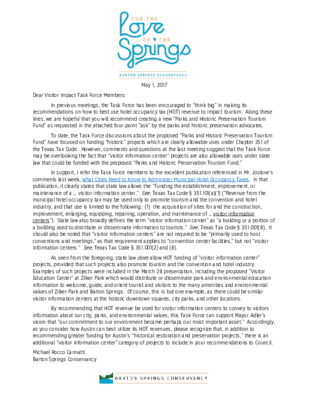Citizen Communications Handout 1 — original pdf
Backup

May 1, 2017 Dear Visitor Impact Task Force Members: In previous meetings, the Task Force has been encouraged to “think big” in making its recommendations on how to best use hotel occupancy tax (HOT) revenue to impact tourism. Along these lines, we are hopeful that you will recommend creating a new “Parks and Historic Preservation Tourism Fund” as requested in the attached four-point “ask” by the parks and historic preservation advocates. To date, the Task Force discussions about the proposed “Parks and Historic Preservation Tourism Fund” have focused on funding “historic” projects which are clearly allowable uses under Chapter 351 of the Texas Tax Code. However, comments and questions at the last meeting suggest that the Task Force may be overlooking the fact that “visitor information center” projects are also allowable uses under state law that could be funded with the proposed “Parks and Historic Preservation Tourism Fund.” In support, I refer the Task Force members to the excellent publication referenced in Mr. Joslove’s comments last week, What Cities Need to Know to Administer Municipal Hotel Occupancy Taxes. In that publication, it clearly states that state law allows the “Funding the establishment, improvement, or maintenance of a … visitor information center.” See, Texas Tax Code § 351.101(a)(1) (“Revenue from the municipal hotel occupancy tax may be used only to promote tourism and the convention and hotel industry, and that use is limited to the following: (1) the acquisition of sites for and the construction, improvement, enlarging, equipping, repairing, operation, and maintenance of … visitor information centers”). State law also broadly defines the term “visitor information center” as “a building or a portion of a building used to distribute or disseminate information to tourists.” See, Texas Tax Code § 351.001(8). It should also be noted that “visitor information centers” are not required to be “primarily used to host conventions and meetings,” as that requirement applies to “convention center facilities,” but not “visitor information centers.” See, Texas Tax Code § 351.001(2) and (8). As seen from the foregoing, state law does allow HOT funding of “visitor information center” projects, provided that such projects also promote tourism and the convention and hotel industry. Examples of such projects were included in the March 28 presentation, including the proposed “Visitor Education Center” at Zilker Park which would distribute or disseminate park and environmental education information to welcome, guide, and orient tourist and visitors to the many amenities and environmental values of Zilker Park and Barton Springs. Of course, this is but one example, as there could be similar visitor information centers at the historic downtown squares, city parks, and other locations. By recommending that HOT revenue be used for visitor information centers to convey to visitors information about our city, parks, and environmental values, this Task Force can support Mayor Adler’s vision that “our commitment to our environment became perhaps our most important asset.” Accordingly, as you consider how Austin can best utilize its HOT revenues, please recognize that, in addition to recommending greater funding for Austin’s “historical restoration and preservation projects,” there is an additional “visitor information center” category of projects to include in your recommendations to Council. Michael Rocco Cannatti Barton Springs Conservancy Please Support the Following Hotel Occupancy Tax Use Recommendationsto the Austin City Council (Per the VITF charge in Resolution No. 20160818-075)1.Create a new “Parks & Historic Preservation Tourism Fund” to repair and improve qualifying city park and historic assets1.Continue to fully fund the Tourism/Promotion Fund (for the ACVB)1.Remove the Heritage Grant Program from the ACVB fund and transfer it to the new Parks & Historic Preservation Tourism Fund1.Continue to fully fund the Cultural Arts FundWe believe the City of Austin can do all of the above and maintain the financial capacity to expand the Convention Center.